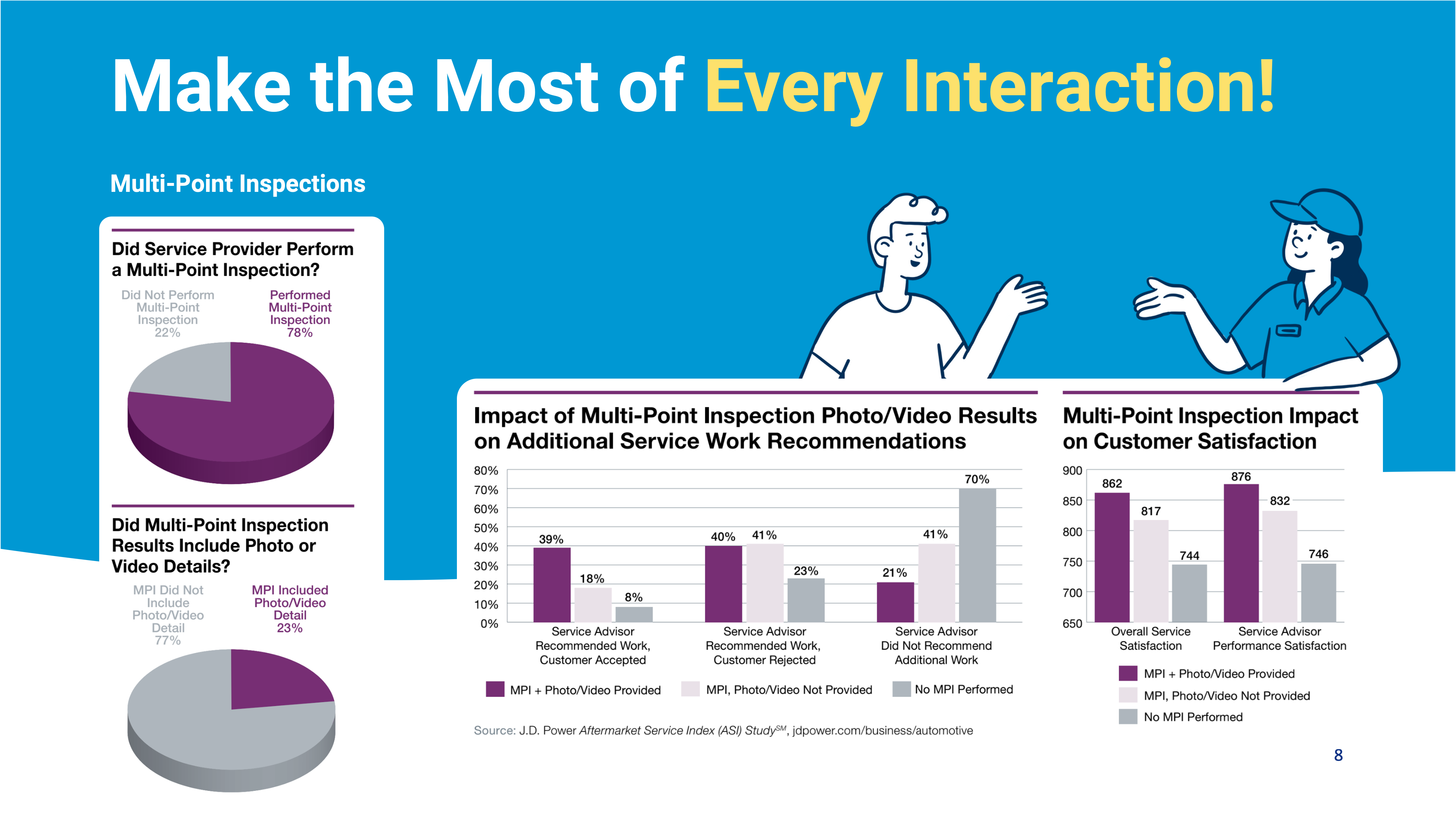The automotive aftermarket industry is undergoing significant changes. From new customer behaviors to advances in technology, it’s important to know what’s happening for your automotive shop’s future success.
Auto Care Association recently released the 2025 Auto Care Factbook, providing auto industry professionals with a comprehensive overview of the entire auto care industry. This article explores five of the aftermarket trends that will shape the automotive industry in 2024 and beyond from the research provided within the Factbook. By understanding these trends, auto repair shops and industry professionals can better prepare for the challenges and opportunities ahead.
1. The Labor Market is Evolving
Technician Supply Meets Demand
Contrary to popular belief, there is evidence showing there is no shortage of automotive technicians. In 2023, employment in this sector increased by 3.6%, matching the demand increase of 3.5%. This means there are enough mechanics for the industry’s needs. This trend is important to understand as it contradicts the common belief that the industry is struggling to find qualified workers.
In reality, the situation is more complex, with several underlying challenges to address. Rising wages and the increasing importance of technician experience are notable issues. Despite having enough technicians, the industry faces significant turnover rates and retention problems.
High Turnover Rates
Even though more people are working as technicians, many leave their jobs quickly. Half of all entry-level technicians from certified programs leave their jobs at independent shops and dealerships within two years. Overall, 30% of technicians leave their jobs each year. This high turnover rate is a major concern for the industry.
High turnover rates are attributed to poor management, lack of career growth, and low pay. Technicians frequently cite inadequate support from management, limited opportunities for advancement, and substandard salaries as reasons for leaving their positions as an automotive mechanic.
Solutions to Labor Market Challenges
Improving Workplace Culture
To keep technicians, it’s important to improve workplace culture, inclusivity, and team dynamics. Creating a positive and inclusive workplace culture is essential. Technicians need to feel valued and respected.
Encouraging teamwork and open communication can significantly enhance job satisfaction. Regular team-building activities can help create a strong sense of community within your shop.
Offering Competitive Pay and Benefits
With wages rising, offering competitive pay and benefits is crucial to find and retain quality mechanics. Regularly review your pay packages to ensure they are fair. Performance-based bonuses and incentives can also motivate technicians. By aligning pay plans with key performance metrics, you can incentivize high-quality work and improve overall job satisfaction.
Providing Career Advancement Opportunities
Technicians are more likely to stay with a company that offers career growth. Implement a career development program that includes training, certifications, and promotions. This helps technicians see a future with your business. Offering structured career paths can significantly reduce turnover and retain skilled workers.
Investing in Training and Education
As vehicles become more complex with diagnostics and electric vehicle EV technology, ongoing training is important. Make sure your technicians have access to the latest training programs. Partner with local technical schools and industry organizations for continuous education. This investment not only improves the skills of your workforce but also shows your commitment to their professional growth.
Partnering with OEMs
Working closely with Original Equipment Manufacturers (OEMs) can provide access to the latest training and parts. OEMs often offer certification programs that can help technicians stay current with new technologies. This partnership can enhance your shop’s reputation and ensure your team is well-equipped to handle modern vehicles.
2. Shifting Customer Loyalty
The automotive repair industry is experiencing the greatest period of price inflation since 1974. The average age of vehicles on the road is rising, and new car purchases are up. This inflation is affecting customer loyalty.
Consumers are feeling increasingly negative about the economy and are looking for ways to save money and increase convenience. Economic uncertainty makes customers cautious with their spending. They may delay necessary repairs or look for cheaper options. Repair shops must find new ways to attract and keep customers.
Strategies to Retain Customers
Conducting Multi-Point Inspections
To keep customers loyal, make the most of every interaction. Conducting multi-point inspections is a valuable tool for building customer trust and loyalty. By thoroughly inspecting each vehicle and providing a detailed report, you show your commitment to customer safety. Highlight potential issues and suggest preventative maintenance.
Building Relationships Online
One of the ways we can speak to customers in between appointments is by using social media. Engage with customers through social media, respond to reviews, and share helpful content. Building a strong online community can foster long-term relationships. Use social media platforms to share tips, promotions, and customer success stories.
Offering Flexible Payment Options
Providing flexible payment options can help retain customers. Offer financing plans, payment plans, and accept various forms of payment. This flexibility helps customers manage repair costs. Highlight these options on your website, social media platforms, and in-store signage.
Enhancing Customer Service
Exceptional customer service is key to keeping customers. Train your staff to be friendly, knowledgeable, and efficient. Make sure every customer feels valued and address any concerns promptly. By exceeding customer expectations, you can build loyalty and encourage repeat business.
3. Financial Constraints on Customers
With 40% of Americans unable to afford an unexpected $400 car repair, financial constraints are a big issue. Many people live paycheck to paycheck, have subprime credit, or no credit score. This affects their ability to pay for necessary repairs.
Economic challenges mean repair shops must help customers with financial limitations. Offering payment and financing options can provide relief and ensure customers can afford repairs.
Offering Financing Options
Providing financing options can be a game-changer. The average repair order when financing is available is about $2,300, nearly triple the national average for mid- to major-repairs. This helps customers manage costs and increases the average transaction value for shops.
Implementing Payment Plans
Offer payment plans that let customers spread repair costs over several months. Partnering with financing companies can make this easier for your shop and customers. Make sure your customers know about financing options.
Highlight your financial options for auto repair services on your website, social media, and in-store. Train your staff to explain and promote financing options effectively.
Providing Transparent Pricing
Transparency in pricing builds trust. Clearly explain the costs associated with each repair and provide detailed estimates. This transparency helps customers feel more confident in their decision to proceed with necessary repairs. Make sure to outline all potential costs upfront to avoid surprises and build a trusting relationship with your clients.
Fair Price Estimator
Leverage RepairPal's Fair Price Estimator to boost your shop's success while offering your customers unmatched value.
Learn More4. Enhanced Focus on Customer Safety
Increase in Road Problems
Car insurance rates have risen by almost 21% over the past year, driven by an increase in claims and riskier driving behaviors such as texting and driving, drinking, and the use of marijuana. Additionally, reliance on car safety features and extreme weather conditions contribute to the increase in accidents.
Promoting Vehicle Safety
Educate your customers on the dangers of risky driving behaviors and the importance of regular maintenance. Provide informational materials and host workshops or seminars to raise awareness about safe driving practices.
Conduct comprehensive safety inspections on every vehicle that comes into your shop. Identify potential safety issues and provide customers with detailed reports and recommendations. Emphasize the importance of addressing these issues promptly to ensure their safety on the road.
Offering ADAS Servicing
Advanced Driver Assistance Systems (ADAS) are becoming more common in modern vehicles. Ensure that your shop is equipped to handle ADAS servicing and recalibration. If necessary, partner with specialized service providers to offer these critical services to your customers.
Promoting Preventative Maintenance
Preventative maintenance is key to ensuring vehicle safety. Educate your customers on the importance of regular maintenance and provide reminders for upcoming service appointments. By helping customers stay on top of maintenance, you can prevent potential safety issues and extend the lifespan of their vehicles.
5. Changing Dynamics in Customer Warranties
Growth in Extended Warranties and Service Plans
Extended warranties and vehicle service plans have had significant growth as vehicles are staying on the road longer. Shops need to justify necessary repairs to warranty companies with DVIs and photo/video proof to navigate these challenges effectively.
Maximizing Warranty Opportunities
Navigating Warranty Challenges
Extended warranties and service plans can help bring in more repair services. Ensure that your staff is well-versed in the terms and conditions of these plans. Provide clear and detailed explanations to customers about what is covered and what is not.
Using Digital Vehicle Inspections (DVIs)
Digital Vehicle Inspections (DVIs) are an effective way to document and justify necessary repairs. Use photos and videos to provide visual proof of issues and needed repairs. This transparency can help build trust with customers and streamline the approval process for warranty claims.
Partnering with Reputable Parts and Accessories Providers
Establishing partnerships with aftermarket parts providers can help you offer cost-effective solutions for warranty repairs. These partnerships allow you to maintain high service standards while managing costs effectively.
Conclusion
By understanding and adapting to current automotive aftermarket trends, businesses can stay competitive and meet the evolving needs of their customers. Focus on improving workplace culture, retaining customer loyalty, offering financial support, enhancing safety, and navigating warranty challenges to thrive in the coming year.
To stay ahead in the automotive aftermarket industry, it’s essential to keep an eye on these key trends. They offer valuable insights into how the market is evolving and what you can do to ensure your business remains competitive. Implementing strategies that address these trends will not only help you retain customers and improve service quality but also enhance overall operational efficiency.
Frequently Asked Questions (FAQ)
The rise in automotive technician wages is primarily due to the increasing demand for skilled technicians and the need to retain experienced employees. As vehicles become more complex, the need for highly trained technicians grows, pushing wages higher to attract and keep talent.
Improving customer loyalty involves making the most of every customer interaction. Conduct multi-point inspections, build relationships online through social media, offer flexible payment options, and provide exceptional customer service. Ensuring that every customer feels valued and addressing their needs promptly can foster long-term loyalty.
Offering financing options can help customers manage the cost of repairs, making it easier for them to afford necessary services. This can increase the average transaction value for your shop and build customer loyalty by providing financial flexibility. Highlighting these options on your website and in your shop can encourage customers to proceed with repairs.
Partnering with Original Equipment Manufacturers (OEMs) for training and certification programs can ensure your technicians stay current with new technologies. Investing in ongoing training and education, and providing access to the latest training programs, can help your team handle modern vehicles effectively.
Promoting vehicle safety involves educating customers on the importance of regular maintenance, addressing risky driving behaviors, and conducting comprehensive safety inspections. Offering services like Advanced Driver Assistance Systems (ADAS) servicing and promoting preventative maintenance can help keep your customers’ vehicles safe and reliable.
Digital Vehicle Inspections (DVIs) provide visual proof of issues and needed repairs, which can help justify necessary repairs under warranty. Using photos and videos to document repairs can build trust with customers and streamline the approval process for warranty claims, ensuring transparency and efficiency.
Resources
The information and statistics for this article were found in the Auto Care Association 2025 Auto Care Factbook.
The Automotive Maintenance and Repair Association (AMRA) and RepairPal recently teamed up to discuss these automotive aftermarket trends in a webinar, “Five Hot Takes on Current Aftermarket Trends”. The webinar features Jeff Cox, President of AMRA, and Kathleen Long, Chief Revenue Officer at RepairPal.





